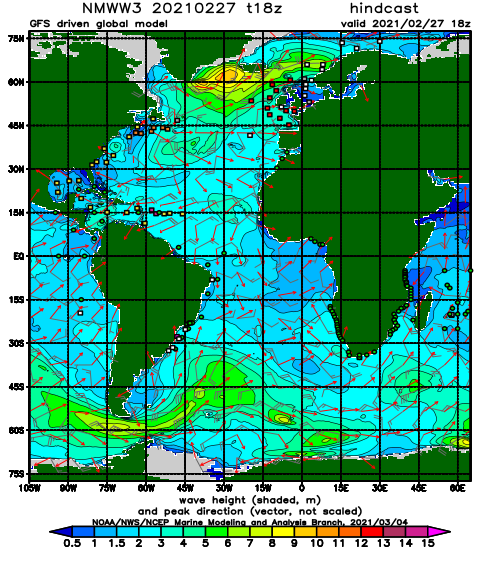Crossing the Atlantic by Sunlight Alone
And raising money for Cancer Research
An academic exercise?
An Autonomous Trans-Atlantic Boat
The first attempt in history to cross the Atlantic with an autonomous solar powered yacht
By John Silvester
The first attempt in history to cross the Atlantic with an autonomous solar powered yacht
By John Silvester
The object of this transatlantic mission
I have a good track record of getting publicity for my projects which have been reported on radio, television and in Science publications (such as the Science page of broad sheets). I intend to fully use my experience to raise a substantial sum for Cancer Relief (U.K.). I have personal reasons for wishing to contribute to this charity, which I do not want to go into here. Most money is spent on treating victims of cancer - preventing cancer would of course save health organisations a great deal of money but above all reduce the chances of any one of us from being afflicted by this most terrifying of diseases. This Transatlantic yacht is also an engaging intellectual exercise. Such a crossing has never been accomplished before.
Is an autonomous boat any use?
Unlike satellite monitoring, an autonomous boat is inexpensive, can monitor continuously at a specific location and can monitor accurately conditions at or below the sea surface in real time. Tethered buoys risk fouling ship's propellers, not a problem with this autonomous boat. Unlike buoys a robotic craft can be deployed to other locations at short notice with little intervention. Our boat called 'Joker' will also carry mail across the Atlantic.
Intended route
Cornwall to Newfoundland via the Great Circle is the shortest distances between the British Mainland to North America. It avoids most of the shipping lanes. A similar route was taken by the first transatlantic cable. The northern route in summer provides almost continuous daylight which will reduce the weight of batteries needed to be carried for progress during the night. The cold sea minimises marine growth on the hull and the North Atlantic drift should keep the sea relatively free of seaweed which could foul the propeller. The North Atlantic is the busiest area for shipping but most vessels tend to take a route following a line of latitude rather than the Great Circle. For them this avoids ice bergs, the stronger headwinds in the northern latitudes and the giant waves generated by the gales. Our little 'Joker' will have to sail into the prevailing wind and waves bigger than houses in order to minimise the risk of being run down by shipping and chance being grounded on an ice berg. The 2,000 nautical mile journey will take about a month, 750 hours at 2.7 knots.
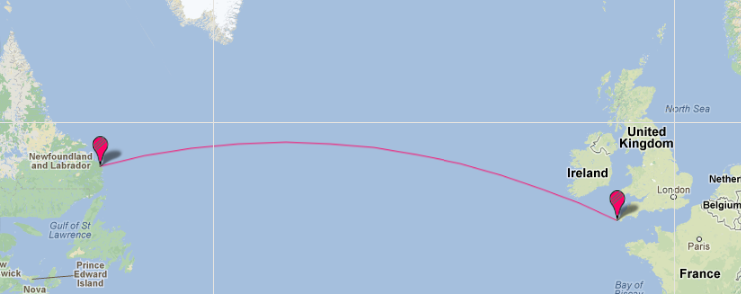
Intended launch date
June this year is a feasible month for departure. The long days are good for generating electrical power. An arrival date in August is envisaged.
The legal matters
Vessels should show due consideration for The Safety of Lives At Sea. The autonomous craft will have low kinetic energy and strength compared to single handed trans-global yacht, designed to survive conditions in the Southern Ocean. These vessels are 'not in command' during much of the race but this is considered acceptable. Like these yachts, a tracker will be installed in this project relaying the boats position hourly and automatically displaying the position on a website. This would be available to the commanders of sea going vessels should they consider avoiding the yacht. However recent experiments would indicate that the bow wave pushes small vessels out of the way and the possibility of an impact is surprisingly small. Impact against the expanded polystyrene hull is unlikely to damage a sea going vessel.
It is legal to sail an autonomous yacht in U.K. territorial waters though I have been advised that informing the local coast guard station might be prudent to avoid confusion should we launch such an unusual craft. I have been pleasantly surprised at the friendly interest shown by the British Authorities and their co-operation in this project.
There is no legal precedent governing autonomous boats sailing to a different country. I intend to keep the Authorities informed of my intensions. Note that Canada is part of the Commonwealth and a successful crossing is expected to raise a considerable sum for charity. One might consider that publicity would be favourable.
The Guidance system
I have been promised the guidance system provided by Robin Lovelock, Sunninghill Systems. This worked well for over 2,000 hours on his 'Snoopy' yacht. I was impressed how the rudder turned automatically to bring the boat's heading towards our chosen trans-Atlantic port wherever the craft was situated and it was also interesting to track the boat - even when he was transporting it down the motorway. The accuracy helped Robin locate the boat when it was taken by a 12 yr old boy.
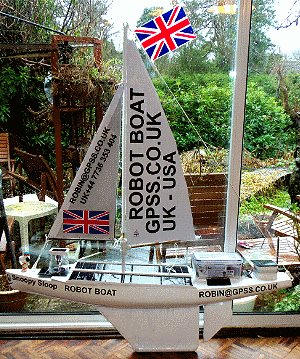
This is Robin's latest boat. Our 5 metre boat is still under construction.
Energy available
From this publication it would appear that a northern route across the Atlantic in summer would present little disadvantage compared to an equatorial crossing -
http://www.fs.fed.us/pnw/pubs/pnw_rp142.pdf
This paper would indicate that at a latitude of 60 degrees north, a horizontal panel would seem to be at just a small disadvantage with regard to direct solar collection. The paper does not take into account cloud cover which would lower incident radiation levels considerably. I have therefore compared values -
At a latitude 60 degrees north on June 22 with the solar panel flat on deck, the relative daily incident radiation energy would be 802.
At the same latitude with the solar panel angled 45 degrees to deck, the relative daily incident radiation energy would be 776, providing the course sailed was ideal for energy collection. A reciprocal course would give a value of 408, this course would minimise energy collection.
At the equator with and the solar panel horizontal, 769 is the maximum relative incident radiation per day.
These figures, I find are amazing. It would indicate that the solar insolation in summer at a latitude of 60 degrees exceeds that at the equator during the course of the day. Unfortunately satellite cloud photographs show that much of the radiation is reflected or absorbed over the North Atlantic. I can only guestimate at the power available to drive the motor.
My current estimate is 10% of the maximum rated power per day from a solar panel.
The Solar Panel
Solar Century have shown an interest in this project.
Their model solarcentury M185 solar module (see the M185 data sheet) has the following specification -
72 monocrystalline cells, each 125mm square in a 6 by 12 array, connected to have an open cell voltage of 44.4V and a maximum efficiency of 14.71% when delivering 5.03A at 36.8V The power rating improves by 0.46% per degree at cooler temperatures so in the cold North Atlantic a slight improvement in power of 1% could be expected. The physical size of this panel is 798mm by 1576 and 35mm deep. It weighs 14.5kg.
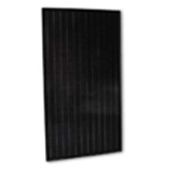
From my guestimate, I would expect a daily average exceeding 10W from this panel if it were laid flat on the deck of our boat. It should be possible to get a reasonable match to the characteristics of the electric motor by employing a solar charge controller and a 24V battery bank. This Steca Solsum one from RS Components might fit the bill.
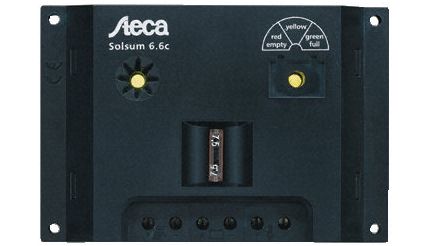
Waterproofing
Previous experiments have found that filling a hull with foam is unsatisfactory. There will always be voids which somehow get filled with water. A solution is to fabricate the hull from foam blocks and cover it with epoxy resin, a technique used to manufacture surf boards. A strong and rigid structure will be possible. Further waterproofing of sensitive components can be achieved by a further covering of ethylene- vinyl acetate film. This film, EVA is commonly used to waterproof solar cells. It melts at a low temperature, is clear and remains flexible. Components which must be open to the atmosphere, such as batteries will be in a sealed container with a venting tube fitted with a gulp valve and leading to a Dorado type air only ventilator.
The Propulsion
My earlier endeavours with Robot Wars introduced me to Parvalux who supplied our 'weapons' motor and have a wide range of motors and gearboxes. This company have been helpful in this project and are in my opinion, best placed to supply a suitable gearmotor for this project. I have been assured that brush life will not be a problem during this 1,000 hour crossing, providing the motor is run within its normal operating conditions.
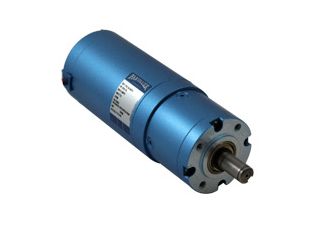
10 Watts give a thrust of 3kg from my experiments which will propel a 75kg hull with ease, probably reaching non-displacement hull speed of 4 knots on flat water. Headwinds and steep waves will reduce this speed considerably.
The Propeller and Stern tube assembly
This is a 280mm diameter two bladed weed-less type with swept back blades.
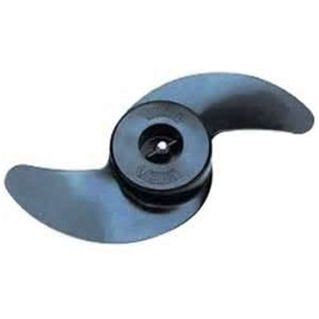
This necessitates a large diameter hub which is about 80mm in diameter. The 62mm carbon fiber stern tube and hub will be faired in to reduce turbulence. The axle hole is about 10mm and I have a 2 metre carbon fiber drive shaft to turn this propeller. The advantage of the long thin drive shaft is that I can make a more efficient stuffing box to protect the electric motor from the ingress of water.
The Hull
With a displacement of less than 75kg the depth of immersion (excluding the keel) is about 3 centimetres and this does not allow a great deal of scope for modelling a 'boaty looking' hull shape. The hull will largely be a lamination of ply and expanded polystyrene joined and covered in epoxy resin.
I have been on a Wessex course on their West products and they have a good range suitable for this project and they are conveniently packaged for easy mixing. Being solvent free epoxy can be used indoors and does not dissolve polystyrene.
A polystyrene 'superstructure' will be needed at each end to right the yacht if it becomes inverted. The hull will have to be long enough so that these superstructures cast very little shadow on the solar cells.
What could possibly go wrong?
Dolphins and whales are curious creatures and will play with strange moving objects. I doubt that they will leave Joker alone, let's hope that he is strong enough to survive their antics.
Waves of 50 ft or more have been reported in the north Atlantic, this link shows the predicted wave height in the next few hours.
Freak waves have sunk sizeable vessels. This video shows the conditions 'Joker' will need to endure. (The camera was about 28 ft above the waves and the vessel was running before the storm. 'Joker' will not be able to turn round and flee the waves)
Being run down by a large vessel. Accidents will happen...
Running into weed which fouls the propeller.
Water getting into the electronics and shorting them out
The boat gets hi-jacked
I made a muck-up of the design and it does not work properly. A most unlikely scenario
Companies assisting in this project
Any company who supported me could gain a great deal of positive publicity and a considerable increase in the traffic to their web site. I am happy to co-operate with any company that will maximise contributions to Cancer Research (U.K.). Some day cancer will be beaten. I intend to bring that day forwards - hopefully with your help.
Individuals wishing to help
I have set up a 'giving' web site Team-joker's Atlantic Challenge fundraiser. Contributions will be gift Aided so an extra 20% will be added to your contribution.
If you would like a little excitement to your giving, you could sponsor us by the number of hours the yacht survives. You will be given a website link just before launch date where you could follow the progress of yacht 'Joker' as he crosses the Atlantic. Your generosity will be acknowledged on this website and noted on the 'Giving' website where your contribution will be sent. If you really like to gamble, please email me your intention to participate and I suggest a minimum of 1p per hour with perhaps all bets off if the boat exceeds more than 2,000 hours or stops transmitting after that time.
There will be a limited space for mail to North America. If you would like to chance Joker carrying a small air mail type letter, please email me for details, john@team-joker.com
Any individual wishing to help fund this initiative please contact me - every little helps, and your contribution will be advertised on this website. If you are living in the Bracknell (U.K.) area wishing to help in other ways, such as in administration, or metal fabrication. Please email me.
If you wish to search for this project on the Virgin money giving website, please enter 'John Silvester' into 'your friends name'.
The work continues - the stern tube arrived this morning.
The turbulenceforecast.com site has wave height charts of the atlantic...
